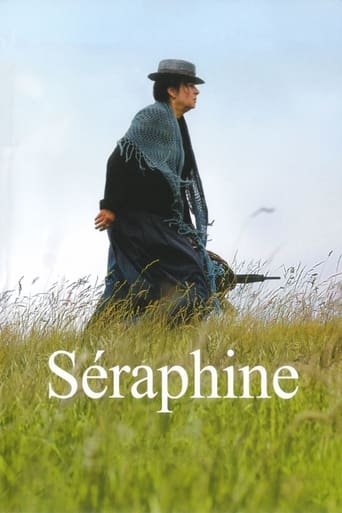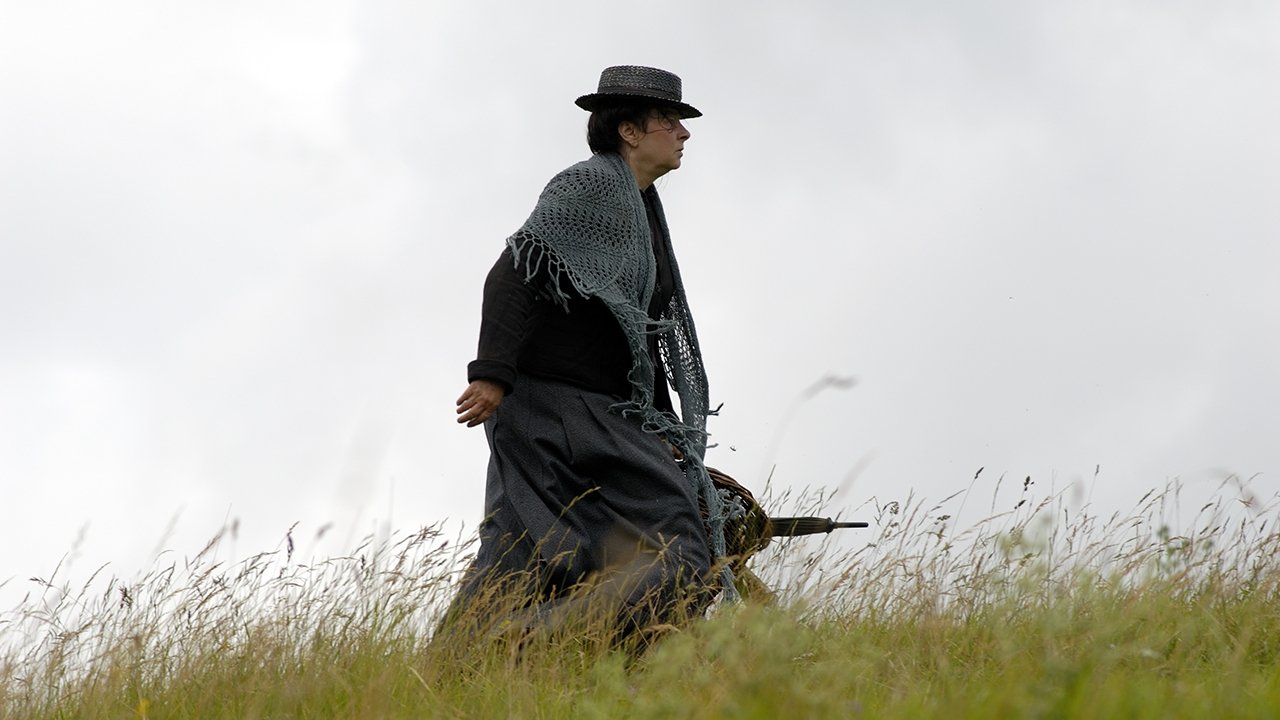MartinHafer
When it comes to historical films, I am one of the most critical people you'll find. That's because as a retired history teacher, I often notice that films often re-write history to make a good story. A good example is "Julie and Julia"--a film that whitewashes one of the protagonists (Julie) to make a sweet story. So, when a film gets the story right--telling the WHOLE story--I really appreciate it."Séraphine" is the unusual and tragic story of a strange figure in the art world, Séraphine Louis. She was an untrained middle-aged domestic worker who has a mission from God--to paint, paint, paint. But she was not painting to sell her work--she was painting because voices told her she MUST paint. Eventually, she was discovered by a German art dealer--but WWI intervened and her whereabouts were lost for over a decade. What happens next is very exciting and very, very tragic. I'd say more, but don't want to ruin the film. But what I will say is that if you want a nice, happy ending, then you should probably NOT see this film.This is a very slow film. This is NOT a negative thing--I liked how the film slowly unfolded. But I mention this because I cannot imagine the average viewer enjoying this film--or at least someone who wants a traditional Hollywood style film. But, if you are willing to sit back and watch, it's well worth your time.
mmunier
Yes Seraphine of Senlis is an interesting film in which you may loose interest! The lead actress was very good and the filming beautiful (if having extended and multiple shots on Seraphine's large behind could be so!). This said I went to see this film and with a little reading had some ideas on what it was about that got me rather eager to go for it. Well it did not work exactly as I anticipated it would, and now I have seen it I share my feeling very much with the last short comment I just read here; I, too, got rather bored, The frequent cutting of the scenes did not work to well for me as I probably would have preferred something more fluid. The slow pace that reminded me a little of a Chinese movie I saw some time ago "Spring time In a small town" where you almost felt that you were watching grass growing! I also have to confess I have problem with the unpleasant side of humanity, so if your are in this category you may share my feelings. But one can not deny reality, although this does not mean that we have to enjoy it all the time and all its forms, but it's fair that it should be portrayed. I have known French rural life post second world war and latter had a similar status as Seraphine had although I was one of the rare person in my category to have been treated as a member of the family I was working for. However I remember others sleeping in some niche in the farm and having their meals in a back room by themselves and eating mostly left overs. I also have a mental-health worker's background here in Australia that started in the early 70's when much improvement came in this area. So, as I watched this movie, there was a fair amount of thoughts that went through my mind. I have to concede, that "entertainment" does not necessarily mean to have pleasant feelings, it can also be interesting or informative. This movie should not come under the "spoilers" rule as it's not a "who done it" and for my own appreciation, I wish I knew a lot more about it than I did. I'm very thankful for a couple of comments so well written I read here that in some ways makes me appreciate 'Seraphine' more than I managed to do at the viewing. I thought the German actor has something familiar about him I could not retrace, and thanks to IMDb I know now he was one of the main characters in what for me was one of the best movies I have ever seen "The Life of Others". I can imagine that having some affinity to painting would add some interest to the enjoyment. Having said all this I certainly don't regret my attendance.
Chris_Docker
Cinema is a language of deception. The set we see, the mise-en-scene, is what the director wants us to see. Conditioning us visually before an actor even speaks their lines. In costume dramas, the historical clothing is a further weapon to impress a specific artistic vision on us, further cloaking any subtext, whether the transformation of a marriage market story into 'rom-com' (Pride & Prejudice) or consciously travestying the past (Moulin Rouge!, Marie Antoinette). French cinema has achieved respected and less controversial use of costume with films like Jean de Florette and Manon des sources. In these examples, beautiful, nostalgic settings were contrasted with dystopian visions of the hard life. When we move to the biopic, cinematic techniques are routinely used to persuade us of 'what really happened.' Séraphine continues the proud French tradition of costume and historical drama, yet in a very accessible vein. It tells the (true) story of a minor French painter, Séraphine Louis (later known as Séraphine de Senlis, after the village where she lived.) Our story picks up Séraphine working as a maid for Madame Duphot. This lady of the house also rents an apartment to a German art critic-dealer, Wilhelm Uhde. Uhde believes in the 'primitive' artists and takes a liking to some of the maid's work he spots. Yolande Moreau's assured performance gives weight to what may be an unvarnished account. The discovery of the peasant woman's talent, her humble charm as she goes about collecting the ingredients for paint (wine, mud, fruits, flowers) as she goes about her chores as a domestic servant. Everything draws us sympathetically into Séraphine's world.Udhe nurtures Séraphine's embryonic talent, ensuring it is seen worldwide. But as war hits the economy, support evaporates. Séraphine's inner voices of inspiration lead her to psychosis and she meets her demise in an insane asylum.The painting itself is of the so-called 'naïve' style, characterized by childlike simplicity. (One of the most famous exponents, according to some, is L. S. Lowry.) The style seems natural to the childlike (if brilliant) personality of our peasant woman, although of course many naive art painters, including Lowry had, unlike Séraphine, plenty of schooling and formal knowledge of art technique.Production values in the film are high all round. Costume, acting, direction, all achieve a high standard, as evidenced by the many awards heaped on it in its own country. The overall effect is touching without being sentimental.Séraphine is a continuation of one woman's barely recognised legacy. Any subtext is about serving up a fine character from France's past, a commemoration of national greatness from the early 20th century. (Visits to the exhibition of her work in Senlis have, predictably, quadrupled since the release of the film.) If there is any ideological weakness, it is simply that held by the character herself, a Christian attitude of sacrifice and acceptance of fate. There is no strong judgement on whether Séraphine could have lived her life differently. No real analysis of her painting style. It is, after all, a classy and enchanting fairy tale hung on the hook of a historical person, a harmless deception perhaps. The viewer, should she or he wish, can make their own judgement. Just as they can on the deeply religious and fairly distinctive artworks she left for posterity.
Howard Schumann
A frumpy cleaning woman well into middle age is discovered by an art critic to be a painter with talent comparable to Vincent Van Gogh. Her story is told in the riveting Seraphine, directed by Martin Provost and winner of seven Césars, the French version of the Oscars, including a best actress award for Yolande Moreau. With a screenplay by Martin Provost and Marc Abdelnour, the film is set in the village of Senlis outside of Paris where Séraphine Louis (Yolande Moreau) lives alone and must take odd jobs just to pay for her painting supplies. Séraphine is a visionary, a devout Catholic who believes she is guided by a guardian angel and her exotic paintings of flowers and plants describe her feelings of closeness to spirit.Treated with disdain by her condescending employer, her life takes on new meaning when a tenant, German art critic Wilhelm Uhde (Ulrich Tukur) hires Séraphine to clean for him and accidentally discovers one of her paintings that her boss had tossed aside. A champion of modern "primitvist" artists who is credited with early recognition of Picasso and Rousseau, Uhde is portrayed by Tukur as a quiet, unassuming man who lives with his sister and a gay lover. He recognizes Séraphine's talent but never shows much enthusiasm, preferring to keep their relationship on a very business-like basis.Impressed by Seraphine's passionate art, Uhde offers to become her patron but, feeling estranged in France, must soon leave the country to return to Germany as the First World War begins. Although Séraphine continues to paint, she has no connection with Uhde until the latter part of the 1920s when he provides her with the means to quit her job and paint full time. Unfortunately, her grip on reality falters and she is soon hospitalized after indulging in spending sprees on a wedding dress and purchase of a large mansion. One of the saddest scenes in the film is that of Séraphine dressed in a full wedding gown, going door to door giving her away her possessions.Provost in Séraphine captures the artist's mystical nature and her close bond with nature that shows up in her works, which are still exhibited in many of the world's museums. She is shown hugging trees, climbing them, and standing as a tiny speck beneath a towering shade tree. One scene shows her standing nude in water up to her chest in a nearby river. Provost takes a minimalist approach and the film does not contain much dialogue. The story is told by the silences and facial expressions and the music by Michael Galasso adds richness to the experience. Fully capturing the eternal mystery of the creative process, Séraphine itself is a work of art.


 AD
AD



